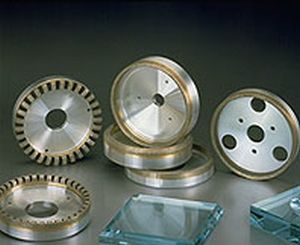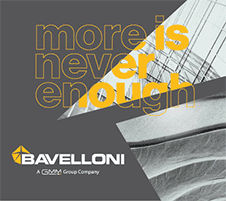Tools and wheels for glass processing
The tools, mainly the wheels are very important to have a good machine working ( quality, productivity, speed..).
They are several different wheels for differents using and goals
1/Diamond wheels
This wheel must remove the glass to reach the final dimension required and give good surface conditions to prepare the polishing.
There are 2 diiferent types:
-The cup wheels ( wheels with a bowl shape) working with the top flat part

Cup diamond wheels from Lanzetta.
-The peripheral wheels working with the throat

Peripheral wheels from Bavelloni.
With cup wheels you can only obtain flat edge with arises. With peripheral wheels you can obtain all kind of edges, the shape of the throat wheels giving the shape for the glass edge.
There are segmented wheels to process laminating glass or when an important removal is required and wheels with continuous crown in other cases
The efficient part of the wheels is a bond where are located the diamond pieces (artificial diamond) which are able to remove glass. When a wheel needs to remove important glass quantities (from 0.2 mm up to 5 mm) a metallic bond is the best solution. To remove small glass quantities (and clean the surface after diamond wheels with metallic bonds) a bakelite bond is the right choice (from 0.01 mm and more up to 0.2 mm). These bonds are mainly used on beveling machines where the quality of the glass surface before polishing with felt and cerium oxide is very important.

Industrial diamond
A bakelite wheels is always a diamond wheels.
For the diamond the main parameters are the geometry, the grit size and the concentration inside the bond.
The secret to manufacture good diamond wheel is the right balance between the bond and the diamond parameters.
-Polishing wheels for glass and stone processing.
With these wheels you need to:
-remove from the glass surface or edge the lines let by the diamond wheels.
-polish the glass surface or edge to have a beautiful appearance

Polishing wheels from Italmole
The polishing wheels are also constituted with a bond and an abrasive material (generally aluminium oxide). The references for the grit size start with 40 (coarse grit size) and go up to 180 (very fine grit size) for the more important market suppliers.
-Stone wheels
There are wheels which have to remove a minimum glass quantity (in case of seams for example, or with the CNC machines) and to give in the same time a good polishing. They are done with synthetic stone.

Stone wheels from Italmole
-White wheels or Cerium wheels
These wheels are not able to remove glass but only to give a bright polishing to the glass surface or edge.

Cerium wheels from Italmole









